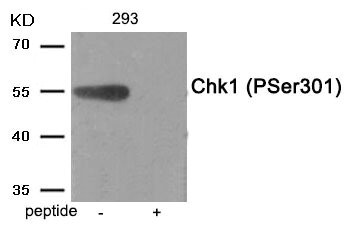
Western blot analysis of extracts from 293 tissue using Chk1 (Phospho-Ser301) antibody.The lane on the right is treated with the antigen-specific peptide.
Phospho-CHEK1 (Ser301) Antibody

CSB-PA779402
ApplicationsWestern Blot, ELISA
Product group Antibodies
ReactivityHuman
TargetCHEK1
Overview
- SupplierCusabio
- Product NamePhospho-CHEK1 (Ser301) Antibody
- Delivery Days Customer20
- ApplicationsWestern Blot, ELISA
- CertificationResearch Use Only
- ClonalityPolyclonal
- ConjugateUnconjugated
- Gene ID1111
- Target nameCHEK1
- Target descriptioncheckpoint kinase 1
- Target synonymscell cycle checkpoint kinase; Checkpoint, S. pombe, homolog of, 1; CHK1; CHK1 checkpoint homolog; Chk1-S; serine/threonine-protein kinase Chk1
- HostRabbit
- IsotypeIgG
- Protein IDO14757
- Protein NameSerine/threonine-protein kinase Chk1
- Scientific DescriptionRequired for checkpoint mediated cell cycle arrest in response to DNA damage or the presence of unreplicated DNA. May also negatively regulate cell cycle progression during unperturbed cell cycles. Recognizes the substrate consensus sequence [R-X-X-S/T]. Binds to and phosphorylates CDC25A, CDC25B and CDC25C. Phosphorylation of CDC25A at Ser-178 and Thr-507 and phosphorylation of CDC25C at Ser-216 creates binding sites for 14-3-3 proteins which inhibit CDC25A and CDC25C. Phosphorylation of CDC25A at Ser-76, Ser-124, Ser-178, Ser-279 and Ser-293 promotes proteolysis of CDC25A. Inhibition of CDC25 activity leads to increased inhibitory tyrosine phosphorylation of CDK-cyclin complexes and blocks cell cycle progression. Binds to and phosphorylates RAD51 at Thr-309, which may enhance the association of RAD51 with chromatin and promote DNA repair by homologous recombination. Binds to and phosphorylates TLK1 at Ser-743, which prevents the TLK1-dependent phosphorylation of the chromatin assembly factor ASF1A. This may affect chromatin assembly during S phase or DNA repair. May also phosphorylate multiple sites within the C-terminus of TP53, which promotes activation of TP53 by acetylation and enhances suppression of cellular proliferation. Enomoto M, et al. (2009)J Biol Chem 284, 34223-3 Ikegami Y, et al. (2008)Biochem Biophys Res Commun 377, 1227-31 Shiromizu T, et al. (2006)Genes Cells 11, 477-85
- ReactivityHuman
- Storage Instruction-20°C or -80°C
- UNSPSC12352203
